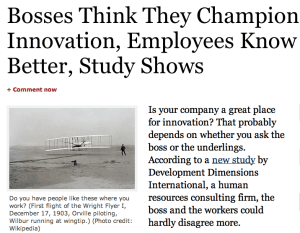
Organizations that are most successful with Kaizen and continuous improvement don't have fancier boards or better software — they have leaders who are more likely engaged with the right behaviors, more consistently. In my experience, I've put the same mechanics in place and given the same training… and some organizations really create a “culture of continuous improvement” and some flounder. The key variable – leadership.
So this Forbes article caught my eye: “Bosses Think They Champion Innovation, Employees Know Better, Study Shows.”
According to a new study by Development Dimensions International, people were asked questions such as if leaders “demonstrate unwavering openness and appreciation for unique ideas and opinions”?
- 78% of leaders said “yes” (about themselves)
- Only 43% of employees agreed with them
Great leaders are self aware… it sounds like many of the survey respondents are not.
Does the leader “guide employees who fail or make mistakes to reframe the experiences as learning opportunities”?
- 77% of leaders said yes
- 47% of employees agreed
Does the leader “champion the merits of employee-initiated ideas to senior management”?
- 75% of leaders said yes
- 42% of employees agreed
The DDI researchers said a leader has four key roles (and I'd agree):
- inspire curiosity
- challenge current perspectives
- create freedom
- drive discipline
Although, I'd maybe define “discipline” as “have a disciplined improvement process” instead of thinking of disciplining employees (as the word “discipline” often implies).
It's a fast-moving world, so it's imperative that we improve more quickly. Kaizen is certainly a form of rapid cycle, small scale innovation. Forbes summarizes:
The study's conclusion recommends that companies work to close that perception gap between leadership and employees and also build both top-down and bottom-up cultures of innovation, examine innovation at every corporate level, “ignite innovation action,” and work tirelessly at continually improving communication.
Other findings from the report summary:
Leaders actions to foster employee innovation will likely fail without an organization-wide commitment to innovation
The more senior the leaders, the more they create the conditions for innovation
Why don't we have more innovation?
Who killed innovation?
When identifying the perpetrator, leaders are less likely to look in the mirror. We asked leaders and team members about barriers to innovation, and both identified the other as the main source of the blockage. Team members are likely to say their leader wants to be the person who generates all the good ideas, while leaders—especially those at higher levels—are most likely to say that their team members don't offer ideas of value.
Leaders need to be willing to give up some control – letting their employees have ideas and implement them. Leaders shouldn't blame their employees for not making improvement happen. Leaders must create an environment where improvement is possible.
What are your thoughts on my summary or the report itself?
Please scroll down (or click) to post a comment. Connect with me on LinkedIn.
Let’s work together to build a culture of continuous improvement and psychological safety. If you're a leader looking to create lasting change—not just projects—I help organizations:
- Engage people at all levels in sustainable improvement
- Shift from fear of mistakes to learning from them
- Apply Lean thinking in practical, people-centered ways
Interested in coaching or a keynote talk? Let’s start a conversation.




![When Was the Last Time a Leader Around You Admitted They Were Wrong? [Poll]](https://www.leanblog.org/wp-content/uploads/2025/07/Lean-Blog-Post-Cover-Image-2025-07-01T212509.843-238x178.jpg)



![When Was the Last Time a Leader Around You Admitted They Were Wrong? [Poll]](https://www.leanblog.org/wp-content/uploads/2025/07/Lean-Blog-Post-Cover-Image-2025-07-01T212509.843-100x75.jpg)

This survey reminds me of how 90% of people think that they are above average drivers. Actually, I’m interested in the 22% of leaders that disagreed with the survey statement of “I demonstrate unwavering openness and appreciation for unique ideas and opinions.” It would take a lot of honesty to realize you aren’t unwaveringly open to ideas.
I think the real issue that the survey addresses is the difference between what leaders would like from their companies and what their cultures and processes actually produce. A culture that truly generates many innovative ideas must also accept many failed attempts as well. It’s a good reminder that no matter what a leader says, its the processes and culture that foster new ideas.
Mark, answering your final question great post, I think that your summary hit all the important points. I agree with Alex and I’m curious about the 22% of leaders that disagree with the statement.
However the big point that I would like to hear more about is the communication process and how to close the gap in understanding between the leader and its team. It seems to me that one of the foundation of lean leadership is understanding reality, if there is a gap on this understanding then any continuous improvement system will not yield its best results, and more importantly it creates unnecessary tension in the relationships at work.
A while ago I had the opportunity to work for a shingo prize winner, and I thought their biggest challenge was this gap, (don’t get me wrong they were a great company and they were moving forward) but when talking to their manager and workers I would get the impression that they were working on two different factories, closing this information gap seemed like their biggest opportunity.
Mark, personally I would like to hear you touch on this area, maybe on a future post or podcast. Thank you for a great blog!
Great post, Mark. Reminds me of Kahneman’s findings that leaders often underestimate the time and cost for various activities. I spend a great deal of my time helping senior leaders and below get aligned about reality. Perceptions are often way off – on both ends of the spectrum.
The most striking thing to me is that, while I agree with the 4 key roles of leadership, I find that the first one is rarely displayed. On the contrary, leaders often discourage curiosity and workers are often ostracized for having ideas. There’s nothing that squelches a person’s espirit de corps faster than having one’s curiosity criticized or ignored. Makes instilling kaizen into the DNA of an organization tough to pull off.
Encouraging and enabling curiosity is perhaps the fastest way to build an Outstanding Organization.